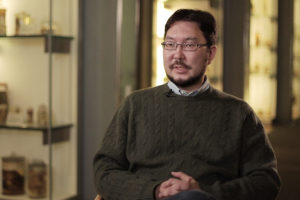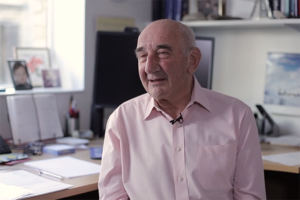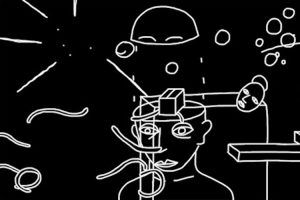Laws of Growth and Natural Selection
Biologist Arkhat Abzhanov on adaptive radiation, Darwin's finches and allopatric speciation
What allows cancer live at high mutation rate? Which mutations make it weaker? Is there a way to exploit its natural mechanisms to make it less evolvable? Harvard Associate Professor, Leonid Mirny, on clinical phenomena we can now explain using the balance between ‘drivers’ and ‘passengers’.
Cancer is an evolutionary process. There are accumulations of mutations and then there is selection from mutations that make cells more malignant, more like cancer cells. Mutations come at random. All genes in all positions in the genome can be mutated. Different positions can be more mutated, others less mutated, but mutations can happen anywhere, and then that can make cells more sick, less fit, or it can make cells more fit and give them some advantage over their neighbors, so that they will start proliferating, and growing, and building the body of a cancer.
But mutations cannot really hit at specific positions. That’s the essence of Darwinian theory of evolution that mutations happen at random. So that means that cells are sitting and waiting for the next mutation, and now we’re talking about cancer, so cancer cells are sitting waiting for the next mutation to happen. When this mutation happens in one of the cells, the cell will take over the population and will form sort of a new layer of cancer, if you wish.
However, the cells are sitting and waiting for the right mutation, so they are getting random mutations. And they are generally getting a little bit sick of this random mutations. These mutations are collectively called ‘passengers’. So those mutations that drive cancer progression are called ‘drivers’ and others are called ‘passengers’. It’s is generally believed that passengers are neutral, they play no role in cancer. Because drivers are usually the same in different patients, but passengers are all different. So in every patient passengers are going to be different from passengers mutations in another patient.
So why bother? We can’t really use them for any therapeutics, – that’s how people usually think about passengers.
However, passengers may not necessarily be neutral. Generally, if you have mutations, mutations usually make cells less fit, make them sort of sick. So what my group is interested in is trying to understand where the passenger mutations may actually be damaging to cancer. Nevertheless, by virtue of cancer sitting and waiting for the next driver and drivers playing the main role in this process, damaging passengers can sort of hitchhike on the driver. And ‘hitchhike’ is not only a metaphorical word here, but it’s actually the name of the genetic process, in which mutations that are not responsible for a specific phenotype can nevertheless sort of propagate jointly with some mutations that lead to a phenotype. In this case cancer cells would accumulate sort of passenger mutations, which might be somewhat damaging. And then one of them would get the driver mutation and found a new population carrying all the baggage of damaging drivers with it.
People have been analyzing cancer genomics data. And when you go in sequence cancer, and compare sequence of a cancer cell from a patient with the sequence of a normal tissue from the same patient you can see tens of thousands of mutations specific to cancer. Only five or ten of those are driver-mutations. We know this because we know that these mutations affect genes known for cancer progression. And we know this because if I would go and compare different patients, I would see only five or ten genes recurrently affected.
And the question that we ask is whether these damaging mutations can make it to the final simulated tumor. And to our great surprise we found that, indeed, hundreds or thousands of passenger mutations that are mildly damaging can nevertheless make it to the final tumor. We say, ok. That’s just a model, it shows that the idea is feasible, that it’s feasible that cancers accumulate damaging mutations. Can we now actually test this by looking at cancer genomics data? So we went into big databases of cancer genomics, looked specifically at those passenger mutations nobody analyzed. People usually look for drivers and then discard passengers. So we looked specifically at those discarded passengers. Say, do these mutations look like neutral, or do they look like damaging? How do we now this without doing experiments?
There is a way, and the approach is based on comparative genomics. If I look at specific mutation, and I see that this particular amino acid in a protein has been conserved for the last 300 million years, it’s been always this specific amino acid, that presumably means that this amino acid needs to be this one. And if I would go and change it, it would make the organism sick. However, there are some amino acids that are changing over time. And if I would go and change it presumably such mutation will have little effect. So we use these tools of comparative genomics to analyze cancer data and what we’ve seen is that passenger mutations look like they are hitting everywhere even in those regions where no mutations were allowed in natural evolution.
So cancer genomics data essentially tells us that passenger mutations that people have largely ignored in the analysis seem to be damaging to cancer cells.
We still need to do experiments to test this. But this is a very provocative hypothesis. Because it essentially tells us that we should start thinking about cancer in a very different standpoint we used to.
The common paradigm of thinking about cancer is that it’s a sequence of unfortunate events. First, you get this mutation, then you get that mutation, then you get another mutation, and then it’s a fully blown clinical cancer. And then, if you get other mutations, it becomes malignant. Now we start thinking about this as a balance between two classes of mutations. There are driver mutations that sort of drive cancer progression, but there is inevitable accumulation of mildly deleterious or damaging passengers. If there are more passengers, cancer may actually melt down spontaneously. And, again clinically, it’s known that small cancers tend to melt down. Large ones are more likely to progress.
And there are lots of other clinical phenomena that we can start explaining using this balance between drivers that lead to progression and passengers that can slow down neoplastic progression. Long periods of dormancy when cancer stays at one size and may shrink and then grow, shrink and grow again, is well characterized clinically, and classical theory doesn’t really know how to explain this thing. Because you should get new mutations if it’s just a sequence of unfortunate events.
So, these mechanisms might be in fact important for cancer progression, because they allow cancer cells to evolve. We are thinking that drugs that target these mechanisms, mechanisms that make cancer cells more evolvable, may actually be a good new generation of drugs. Other things, like increasing elevating temperature, may actually do the job. Because when there are more mutations, proteins are less healthy, so high temperature would make them break down. This is our thinking, again, it still needs to be all tested experimentally, these are only first steps in this direction. But we are generally sort of very optimistic thinking about therapies in cancer that are not trying to kill cancer cells, but are trying also to make cancer cells less evolvable. Because evolvability of cancer cells is, in fact, the main killer. No matter what drug you give they evolve ability to be resistant to this drug.
If we can actually target the sole evolvability of cancer cells, we may actually slow down cancer progression.
We still do not fully understand what’s the role of passenger mutations. We hypothesize that they are damaging, but we don’t know to what extent they are damaging, this needs to be tested experimentally. Again, we can do genomic analysis and simulations, but experiments on cells and small animals will actually tell us this. We would like to see whether the number of mutations is actually prognostic of the course of the disease. Some cancers will have more mutations, some less. So what’s the effect of these passenger mutations on the actual progression of the disease? And we would also like to see whether types of passenger mutations – because there might be several types of passenger mutations, right now we put them all together – so whether types of passenger mutations may actually determine phenotype of cancer cells. Some mutations would make them look different, some mutations will make the cells more sick. And finally, we would like to know what are the biological mechanisms that allow cells to evolve while accumulating these bad mutations. We see that there are bad mutations, we see that cancers accumulate them, we don’t know how it manages to live with this load of passenger mutations.

Biologist Arkhat Abzhanov on adaptive radiation, Darwin's finches and allopatric speciation

Respiratory scientist Peter Barnes on the Chronic obstructive pulmonary disease, responsiveness to steroids, a...

Neuroscientist Klaus Linkenkaer-Hansen on the biology of mind-wandering, training one's attention, and the rol...